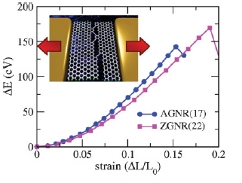The electrical response of graphene-based materials can be tailored under mechanical stress. We report different switching behaviors that take place in mechanically deformed graphene nanoribbons prior to the breakage of the junction. By performing tight-binding molecular dynamics, the study of structural changes of graphene nanoribbons with different widths is achieved, revealing that carbon chains are the ultimate bridges before the junction breaks. The electronic and transport calculations show that binary on/off states can be switched prior to and during breakage depending on the atomic details of the nanoribbon. This work supports the interpretation of recent experiments on nonvolatile memory element engineering based on graphene break junctions.

The electrical response of graphene-based materials can be tailored under mechanical stress. We report different switching behaviors that take place in mechanically deformed graphene nanoribbons prior to the breakage of the junction. By performing tight-binding molecular dynamics, the study of structural changes of graphene nanoribbons with different widths is achieved, revealing that carbon chains are the ultimate bridges before the junction breaks. The electronic and transport calculations show that binary on/off states can be switched prior to and during breakage depending on the atomic details of the nanoribbon. This work supports the interpretation of recent experiments on nonvolatile memory element engineering based on graphene break junctions.
